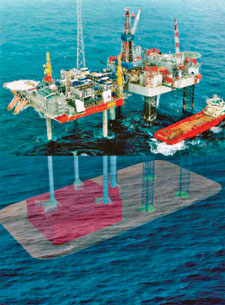 |
the Netherlands |
|
Mobile production unit with storage
For many years, but especially in the past few, mobile production units (MOPUs) have shown to provide flexible and cost-effective solutions for development of oil and gas fields worldwide. Emphasis has been placed on deeper water applications using ship-shape or semi-submersible units, first converted from tankers or drilling units – more recently, however, in the form of newbuild units specifically designed for production, i.e., FPSOs.
 |
Siri field subsea storage and jackup rig operating in the Danish North Sea.
|
|
For the more shallow waters, converted older jackups have been used to provide fast track and cost-effective MOPUs. The cost effectiveness of these solutions was partly created by the low cost for an existing aging jackup drilling unit, but the main economic advantage is created through its possibilities for fast-track development, financial and operational leasing, and the fact that such units can be installed without a requirement for expensive installation equipment.
Success of floating and seabed-supported mobile solutions for field development led to newbuild MOPUs proven using jackup technology.
The MOPUstor, developed by Marine Structure Consultants (MSC), provides a solution for short-life oil fields without direct access to pipeline infrastructure in water depths and environments not suitable for an FPSO. This concept comprises a steel storage tank supported directly on the seabed, three (or four) tubular legs firmly connected to the storage tank, a barge type platform deck that can be jacked along the legs, and a jacking system.
The storage tank is a steel-plated structure constructed much like a section of an oil tanker. Oil is stored in the tank using a water displacement system such that the tank is effectively pressureless. The storage tank doubles as the foundation for the entire platform and provides structural support for the jackup production platform. The integrated well caisson contains slots for 12 wells and all risers and J-tubes. All piping is protected by the caisson.
The tank and the well caisson are installed by ballasting the tank down and penetrating the skirts into the sea bottom by weight and suction. The well caisson then functions as a wellhead platform for pre-drilling surface completed wells. The deck is installed on the steel tank after the pre-drilling period by inserting the legs in sleeves in the tank and grouting the annulus after elevating the deck.
The production deck is essentially a barge type structure similar to many jackup hulls. It provides buoyancy to enable transport to, and installation on, the site. A large flat deck is available to install the production equipment, and below deck space is available for utility tanks and non-hazardous equipment.
The legs are straight tubular legs, fabricated in the same manner as large jacket legs. The legs, however, are free of any nodes or additional welding. Seawater lift pumps and drain caissons are located in the legs.
The jacking system is the MSC hydraulic cylinder type using a pin/ hole system for contact with the leg. This is a field-proven system. Used on 10 jackups, it raises the platform out of the water to operational height and locks the platform to the hull during field life. Further, it provides the capability to remobilize.
The first MOPUstor, designed by MSC, constructed by Kvaerner, and installed in Siri field in the Danish North Sea in late 1998 for Statoil, is now operated by DONG and has performed successfully for six years. Key structural statistics include: water depth: 65 m; deck size: 57 m X 50 m X 6.7 m; leg diameter: 3.5 m; 12-slot well caisson: 5.25 m diameter; and net storage capacity: 50,000 m3. 
|




